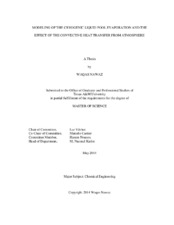| dc.description.abstract | Liquefied Natural Gas (LNG) has recently known significant development worldwide. The assessment and the control of the risks associated to the production, storage and transportation of LNG is of paramount importance to ensure the sustainability of this activity. This includes the prediction of the consequences of potential loss of containment of LNG, which requires the modelling of the vaporization rate of LNG resulting from the heat transfer between the pool and surroundings. The present work focuses on the role of evaporation and convection phenomena on the cryogenic pool temperature and its vaporization rate. Various models describing heat transfer by evaporation were compared. The models differ from each other in terms of mass transfer coefficient and saturation vapor pressure (i.e. linear versus logarithmic expression). Simulations were performed to observe the temperature and vaporization rate of cryogenic liquid pool (methane/nitrogen) under known atmospheric conditions. The results show that the pool initially stays at its boiling temperature, for models using linear driving force, such indicating the prevalence of boiling on the overall vaporization rate. Subsequently, the temperature of the cryogenic pool drops down, as the heat taken by evaporation exceeds the heat transfer by convection or conduction whereas, models adopting logarithmic driving force show drop in temperature from the beginning of simulation. The results of these models were compared to existing experimental data for cryogenic liquid vaporization rate to assess their accuracy and clarify the role of evaporation in the vaporization of a cryogenic liquid pool. | en |


